Vanda
| Vanda | |
|---|---|
| | |
| Vanda coerulea, the blue orchid | |
| Scientific classification | |
| Kingdom: | Plantae |
| Clade: | Angiosperms |
| Clade: | Monocots |
| Order: | Asparagales |
| Family: | Orchidaceae |
| Subfamily: | Epidendroideae |
| Tribe: | Vandeae |
| Subtribe: | Aeridinae |
| Genus: | Vanda Gaud. ex Pfitzer |
| Synonyms[1] | |
| |
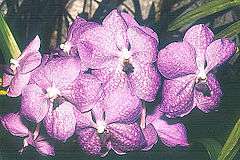
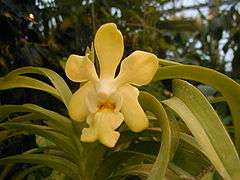


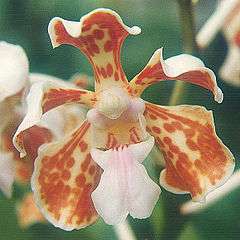
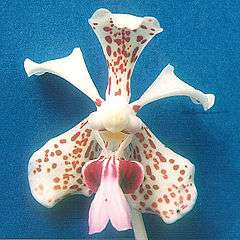
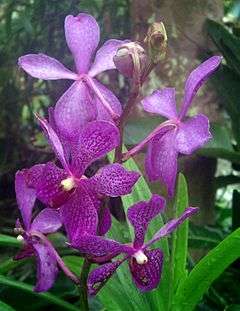
Vanda is a genus in the orchid family (Orchidaceae), which although not massive (about 80 species), is one of the genera more commonly found in the marketplace. This genus and its allies are considered to be among the most specifically adapted of all orchids within the Orchidaceae. The genus is highly prized in horticulture for its showy, fragrant, long-lasting, and intensely colorful flowers.[2] Vanda species are widespread across East Asia, Southeast Asia, and New Guinea, with a few species extending into Queensland and some of the islands of the western Pacific.[1][3] The genus is sometimes abbreviated as V. in the floral trade.
Systematic
In a recent molecular study of the genus Vanda ,[4] several Genera including the former Genus Ascosentrum, Neofinitea and Euanthe were believed as a synonym of Vanda,[5][6]
Biology
The name "Vanda" is derived from the Sanskrit (वन्दाका)[7] name for the species Vanda roxburghii(Synonym of Vanda tessellata).[8][9]
These mostly epiphytic, but sometimes lithophytic or terrestrial orchids, are distributed in India, Himalaya, Southeast Asia, Indonesia, the Philippines, New Guinea, southern China, and northern Australia.
The genus has a monopodial growth habit with highly variable leaves according to habitat. Some have flat, typically broad, ovoid leaves (strap-leaves), while others have cylindrical (terete), fleshy leaves and are adapted to dry periods. The stems of these orchids vary considerably in size; some are miniature plants and some have a length of several meters. The plants can become quite massive in habitat and in cultivation, and epiphytic species possess very large, rambling aerial root systems.
The few to many flattened flowers grow on a lateral inflorescence. Most show a yellow-brown color with brown markings, but they also appear in white, green, orange, red, and burgundy shades. The lip has a small spur. Vanda species usually bloom every few months and the flowers last for two to three weeks.
Many Vanda orchids (especially V. coerulea) are endangered, and have never been common because they are usually only infrequently encountered in habitat and grow only in disturbed forest areas with high light levels, and are severely threatened and vulnerable to habitat destruction.[2] The export of wild-collected specimens of the blue orchid (V. coerulea) and other wild Vanda species is prohibited worldwide, as all orchids are listed on Appendix II of the Convention on International Trade in Endangered Species.
Cultivation
This genus is one of the five most horticulturally important orchid genera, because it has some of the most magnificent flowers to be found in the orchid family. This has contributed much to the work of hybridists producing flowers for the cut flower market. V. coerulea is one of the few botanical orchids which can produce varieties with blue flowers (actually a very bluish purple), a property much appreciated for producing interspecific and intergeneric hybrids.
The color blue is rare among orchids, and only Thelymitra crinita, a terrestrial species from Australia, produces flowers that are truly "blue" among the orchids, the other being Aganisia cyanea, a lowland species from northern South America that is difficult to cultivate, but has metallic blue flowers. Both of these species, much like Vanda, also have a bluish-purple tint towards the inner petals of the flowers.
V. dearei is one of the chief sources of yellow color in Vanda hybrids. Vanda 'Miss Joaquim', a terrestrial Vanda variety and natural hybrid with terete (cylindrical) leaves, is the national flower of Singapore.
The plants do not possess pseudobulbs, but do possess leathery, drought-resistant leaves. Almost all of the species in this genus are very large epiphytes found in disturbed areas in habitat and prefer very high light levels, the plants having large root systems. Some of these species have a monopodial vine-like growth habit, and the plants can quickly become quite massive.
These plants prefer consistent conditions day-to-day in cultivation to avoid dropping their bottom leaves. The epiphytic species are best accommodated in large wooden baskets, bare rooted, which allows for the large aerial root systems. Disturbing or damaging the roots of large, mature vandaceous orchid plants, and in particular, Vanda and Aerides species, can result in the plants failing to flower and going into decline for a season or more. These plants do not tolerate disturbance or damage of their root systems in cultivation when they become mature. The terete-leaved terrestrial species are very easy to cultivate.
When grown bare-rooted, the epiphytic species require daily watering and weekly feeding and are very heavy feeders in cultivation. They can be grown out-of-doors in Hawaii and the like provided they are given some shade.
Species
- Vanda alpina (Himalaya to China - S. Yunnan)
- Vanda arbuthnotiana (India)
- Vanda arcuata (Indonesia - Sulawesi)
- Vanda barnesii (North Luzon, Philippines)
- Vanda bensonii (Assam to Thailand)
- Vanda bicolor (Bhutan)
- Vanda bidupensis (Vietnam)
- Vanda brunnea (China - Yunnan to Indo-China)
- Vanda celebica (Indonesia – Sulawesi)
- Vanda chlorosantha (Bhutan)
- Vanda coerulea : "Blue Orchid" (Assam to China - S. Yunnan)
- Vanda coerulescens (Arunachal Pradesh to China - S. Yunnan)
- Vanda concolor (S. China to Vietnam)
- Vanda cristata (Himalaya to China - NW. Yunnan)
- Vanda dearei (Borneo)
- Vanda denisoniana (China - Yunnan to N. Indo-China)
- Vanda devoogtii (Sulawesi)
- Vanda falcata (Japan, China, Korea)
- Vanda flabellata (Rolfe ex Downie) Christenson, 1985
- Vanda foetida (S. Sumatra)
- Vanda furva (Java, Maluku)
- Vanda fuscoviridis (S. China to Vietnam)
- Vanda griffithii (E. Himalaya)
- Vanda hastifera (Borneo)
- Vanda hastifera var. gibbsiae (Sabah)
- Vanda hastifera var. hastifera (Borneo)
- Vanda helvola (W. Malaysia to Philippines)
- Vanda hindsii (Papuasia to N. Queensland)
- Vanda insignis (Lesser Sunda Is.)
- Vanda jainii (Assam)
- Vanda javierae (Philippines - Luzon)
- Vanda jennae P.O'Byrne & J.J.Verm., 2005
- Vanda lamellata (Taiwan, Philippines, Sabah)
- Vanda lamellata var. boxallii
- Vanda lamellata var. calayana (synonym of the accepted name V. lamellata var. lamellata)
- Vanda lamellata var. flava
- Vanda lamellata var. lamellata
- Vanda lamellata var. remediosae (synonym of the accepted name V. lamellata var. boxallii Rchb.f. )
- Vanda leucostele (N. and W. Sumatra)
- Vanda lilacina (China - Yunnan to Indo-China)
- Vanda limbata (Java, Lesser Sunda Is., Philippines - Mindanao)
- Vanda lindenii (Maluku). (synonym of the accepted name V. furva (L.) Lindl. )
- Vanda liouvillei (Assam to Indo-China)
- Vanda lombokensis (Lesser Sunda Is.)
- Vanda luzonica (Philippines - Luzon)
- Vanda merrillii (Philippines)
- Vanda merrillii var. immaculata (synonym of the accepted name V. merrillii Ames & Quisumb. )
- Vanda merrillii var. rotorii (synonym of the accepted name V. merrillii Ames & Quisumb. )
- Vanda metusalae P.O'Byrne & J.J.Verm. (2008)
- Vanda motesiana Choltco (2009)
- Vanda petersiana (Myanmar)
- Vanda pumila (Nepal to Hainan and N. Sumatra)
- Vanda punctata (Pen. Malaysia)
- Vanda roeblingiana (Philippines - Luzon)
- Vanda sanderiana (now synonym of Euanthe sanderiana)
- Vanda scandens (Borneo, Philippines - Mindanao)
- Vanda spathulata (India -Kerala, Tamil Nadu, Sri Lanka)
- Vanda stangeana (India - Arunachal Pradesh to Assam)
- Vanda subconcolor (China - SW. Yunnan to Hainan)
- Vanda subconcolor var. disticha (Hainan) (synonym of the accepted name V. subconcolor Tang & F.T.Wang , 1974)
- Vanda sumatrana (Sumatra)
- Vanda tessellata (Indian subcontinent to Indo-China)
- Vanda testacea (Indian subcontinent to SC. China).
- Vanda thwaitesii (S. India, Sri Lanka)
- Vanda tricolor (Laos, Java, Bali)
- Vanda ustii (Philippines - Luzon)
- Vanda vipanii (Myanmar)
- Vanda wightii (S. India)
Natural hybrids
- Vanda × boumaniae (V. insignis × V. limbata) (Lesser Sunda Is.)
- Vanda × charlesworthii (V. bensonii × V. coerulea) (Myanmar)
- Vanda × confusa (V. coerulescens × V. lilacina) (Myanmar)
Intergeneric hybrids
- Aeridovanda (Aerides × Vanda)
- Aeridovanisia (Aerides × Luisia × Vanda)
- Alphonsoara (Arachnis × Ascocentrum × Vanda × Vandopsis)
- Andrewara (Arachnis × Renanthera × Trichoglottis × Vanda)
- Aranda (Arachnis × Vanda)
- Ascocenda (Ascocentrum × Vanda)
- Ascovandoritis (Ascocentrum × Doritis × Vanda)
- Bokchoonara (Arachnis × Ascocentrum × Phalaenopsis × Vanda)
- Bovornara (Arachnis × Ascocentrum × Rhynchostylis × Vanda)
- Burkillara (Aerides × Arachnis × Vanda)
- Charlieara (Rhynchostylis × Vanda × Vandopsis)
- Christieara (Aerides × Ascocentrum × Vanda)
- Darwinara (Ascocentrum × Neofinetia × Rhynchostylis × Vanda)
- Debruyneara (Ascocentrum × Luisia × Vanda)
- Devereu×ara (Ascocentrum × Phalaenopsis × Vanda)
- Eastonara (Ascocentrum × Gastrochilus × Vanda)
- Fujiora (Ascocentrum × Trichoglottis × Vanda)
- Goffara (Luisia × Rhynchostylis × Vanda)
- Hawaiiara (Renanthera × Vanda × Vandopsis)
- Hagerara (Doritis × Phalaenopsis × Vanda)
- Himoriara (Ascocentrum × Phalaenopsis × Rhynchostylis × Vanda)
- Holttumara (Arachnis × Renanthera × Vanda)
- Isaoara (Aerides × Ascocentrum × Phalaenopsis × Vanda)
- Joannara (Renanthera × Rhynchostylis × Vanda)
- Kagawara (Ascocentrum × Renanthera × Vanda)
- Knappara (Ascocentrum × Rhynchostylis × Vanda × Vandopsis)
- Knudsonara (Ascocentrum × Neofinetia × Renanthera × Rhynchostylis × Vanda)
- Leeara (Arachnis × Vanda × Vandopsis)
- Luisanda (Luisia × Vanda)
- Luivanetia (Luisia × Neofinetia × Vanda)
- Lewisara (Aerides × Arachnis × Ascocentrum × Vanda)
- Maccoyara (Aerides × Vanda × Vandopsis)
- Macekara (Arachnis × Phalaenopsis × Renanthera × Vanda × Vandopsis)
- Micholitzara (Aerides × Ascocentrum × Neofinetia × Vanda)
- Moirara (Phalaenopsis × Renanthera × Vanda)
- Mokara (Arachnis × Ascocentrum × Vanda)
- Nakamotoara (Ascocentrum × Neofinetia × Vanda)
- Nobleara (Aerides × Renanthera × Vanda)
- Okaara (Ascocentrum × Renanthera × Rhynchostylis × Vanda)
- Onoara (Ascocentrum × Renanthera × Vanda × Vandopsis)
- Opsisanda (Vanda × Vandopsis)
- Pageara (Ascocentrum × Luisia × Rhynchostylis × Vanda)
- Pantapaara (Ascoglossum × Renanthera × Vanda)
- Paulara (Ascocentrum × Doritis × Phalaenopsis × Renanthera × Vanda)
- Pehara (Aerides × Arachnis × Vanda × Vandopsis)
- Pereiraara (Aerides × Rhynchostylis × Vanda)
- Phalaerianda (Aerides × Phalaenopsis × Vanda)
- Raganara (Renanthera × Trichoglottis × Vanda)
- Ramasamyara (Arachnis × Rhynchostylis × Vanda)
- Renafinanda (Neofinetia × Renanthera × Vanda)
- Renanda (Arachnis × Renanthera × Vanda)
- Renantanda (Renanthera × Vanda)
- Rhynchovanda (Rhynchostylis × Vanda)
- Ridleyare (Arachnis × Trichoglottis × Vanda)
- Robinaria (Aerides × Ascocentrum × Renanthera × Vanda)
- Ronnyara (Aerides × Ascocentrum × Rhynchostylis × Vanda)
- Sanjumeara (Aerides × Neofinetia × Rhynchostylis × Vanda)
- Sarcovanda (Sarcochilus × Vanda)
- Shigeuraara (Ascocentrum × Ascoglossum × Renanthera × Vanda)
- Stamariaara (Ascocentrum × Phalaenopsis × Renanthera × Vanda)
- Sutingara (Arachnis × Ascocentrum × Phalaenopsis × Vanda × Vandopsis)
- Teohara (Arachnis × Renanthera × Vanda × Vandopsis)
- Trevorara (Arachnis × Phalaenopsis × Vanda)
- Trichovanda (Trichoglottis × Vanda)
- Vascostylis (Ascocentrum × Rhynchostylis × Vanda)
- Vandachnis (Arachnis × Vandopsis)
- Vancampe (Acampe × Vanda)
- Vandachostylis (Rhynchostylis × Vanda)
- Vandaenopsis (Phalaenopsis × Vanda)
- Vandaeranthes (Aeranthes × Vanda)
- Vandewegheara (Ascocentrum × Doritis × Phalaenopsis × Vanda)
- Vandofinetia (Neofinetia × Vanda)
- Vandofinides (Aerides × Neofinetia × Vanda)
- Vandoritis (Doritis × Vanda)
- Vanglossum (Ascoglossum × Vanda)
- Wilkinsara (Ascocentrum × Vanda × Vandopsis)
- Yapara (Phalaenopsis × Rhynchostylis × Vanda)
- Yusofara (Arachnis × Ascocentrum × Renanthera × Vanda)
- Yonezawaara (Neofinetia × Rhynchostylis × Vanda)
References
- 1 2 Kew World Checklist of Selected Plant Families
- 1 2 The Orchids, Natural History and Classification, Robert L. Dressler. ISBN 0-674-87526-5
- ↑ Flora of China v 25 p 471, 万代兰属 wan dai lan shu, Vanda Jones ex R. Brown, Bot. Reg. 6: ad t. 506. 1820.
- ↑ "RAPD Analysis of Some Species in the GenusVanda(Orchidaceae)". Annals of Botany. 83: 193–196. doi:10.1006/anbo.1998.0801.
- ↑ http://www.ipni.org/ipni/idPlantNameSearch.do?id=661063-1&back_page=%2Fipni%2FeditSimplePlantNameSearch.do%3Ffind_wholeName%3DVanda%2Bsanderiana%26output_format%3Dnormal
- ↑ http://apps.kew.org/wcsp/namedetail.do?name_id=211529M
- ↑ vandAkA Sanskrit English Dictionary, University of Koeln, Germany
- ↑ Vanda Taxonomy Research & Information Network, Australia (2009)
- ↑ Garay, L. (1972), On the systematics of the monopodial orchids, Bot. Mus. Leafl. Harvard University, 23(4): 149-212
- ↑ World Checklist of Selected Plant Families : Vanda
Further reading
- Grove, D. L. 1995. Vandas and Ascocendas. Timber Press, Portland, Oregon. 241 pp.
- Motes, Martin R., and Alan L. Hoffman. 1997 Vandas, Their botany, history and culture. ISBN 0-88192-376-1
External links
-
 Media related to Vanda at Wikimedia Commons
Media related to Vanda at Wikimedia Commons -
 Data related to Vanda at Wikispecies
Data related to Vanda at Wikispecies - Breeding in Vanda Breeding in Vanda
- Vanda Orchid Forum
- Green Culture Singapore Forum
- Vanda Miss Joaquim